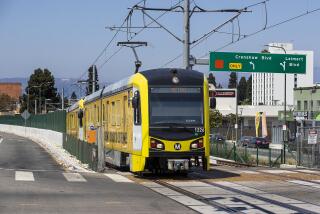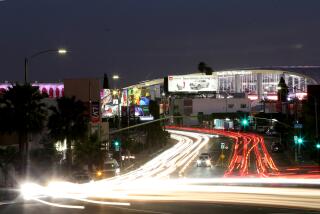Same Status as Old Town Line : Priority of Santee Trolley Route Is Upgraded
- Share via
A trolley line linking El Cajon and Santee and another between downtown San Diego and Old Town were given equal priority Thursday when local transit officials decided to seek funding for both lines at the same time.
Previously, the $56.4-million Old Town Line had been ranked ahead of the $37.1-million Santee Extension by the Metropolitan Transit Development Board. The two routes now share the third-place ranking on the priority list, behind the East Line from downtown to El Cajon and the Bayside Line connecting downtown with the convention center.
Although the plan to give Old Town and Santee equal priority in the trolley’s blueprint for future growth was described by the MTDB’s staff as a compromise, it followed heated debate between representatives of the San Diego City Council and the cities of Santee and La Mesa.
San Diego Councilman Uvaldo Martinez and acting Mayor Ed Struiksma unsuccessfully attempted to delay passage of the proposal after Santee Councilman Jim Bartell introduced an amendment to the staff-authored compromise specifying that any discretionary funds (subsidies not earmarked for a specific route) secured for the trolley would be divided equally between the two lines.
Bartell, who earlier had attempted to persuade the board to place the Santee extension ahead of Old Town, said the language was necessary “so we establish from the beginning that the lines are truly on an equal basis.”
Martinez, the lone board member to vote against the amendment, called Bartell’s amendment a “new element,” saying it impeded his “ability to represent the interests of the City of San Diego.”
“I don’t like being surprised,” Martinez said. “This only creates additional tensions between the various jurisdictions represented on this board.”
La Mesa Mayor Fred Nagel led the movement to forgo the delay, saying he saw “no need for delay and undue back-room lobbying” by the City of San Diego.
While Martinez and Struiksma expressed concern for the city’s welfare, Councilman William Jones, in supporting the compromise, said: “I don’t see the City of San Diego being hurt at all by this.”
And MTDB Chairman Leon Williams, a county supervisor, said he backed the plan because it “resolved regional problems.”
“If it relieves the congestion along Interstate 8, it will be a benefit to the city,” he said of the Santee Extension.
The two lines will continue to compete for state and federal discretionary funding, and while they share the same position on the MTDB priority list, they are not likely to be built simultaneously.
“Applications can be filed for both projects at the same time,” MTDB counsel Jack Limber said, “but the state Transportation Commission (which doles out mass-transit monies) will ultimately decide which line is actually going to receive money first, so you probably will not achieve the end result you are seeking today.”
Applications for funds probably will be submitted within three months. Neither line is expected to be operating until at least 1990.
MTDB general manager Tom Larwin, in a report to the board, said: “It would seem prudent to designate both segments as high-priority . . . projects and pursue implementation of both as soon as possible.”
The ridership of the Santee Extension is predicted to be 99% local residents, and, with the rapid development in East County, “it received the most positive rating with respect to serving growth areas,” Larwin said. About 10% of the riders on the Old Town Line will be tourists, according to MTDB estimates.
Both routes are expected to relieve freeway congestion, Larwin said, although the snarls along Interstate 8 “result in a greater need for the Santee Extension.” The Old Town Line has a more favorable rating on ability to secure funding, but the Santee Extension is “more advanced in meeting environmental process requirements for either state or federal funds.”
More to Read
Sign up for Essential California
The most important California stories and recommendations in your inbox every morning.
You may occasionally receive promotional content from the Los Angeles Times.










